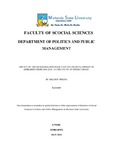Please use this identifier to cite or link to this item:
https://cris.library.msu.ac.zw//handle/11408/2779Full metadata record
| DC Field | Value | Language |
|---|---|---|
| dc.contributor.author | Whena, Melody | - |
| dc.date.accessioned | 2017-08-29T13:39:22Z | - |
| dc.date.available | 2017-08-29T13:39:22Z | - |
| dc.date.issued | 2015 | - |
| dc.identifier.uri | http://hdl.handle.net/11408/2779 | - |
| dc.description.abstract | Since Zimbabwe’s political independence in 1980, the government has been making efforts of trying to raise the living standards of the young people through various means. However, because of a variety of challenges and other factors like colonial policies, national divisions, illiteracy, selfishness and a poorly performing economy amongst others, unemployment has continued to affect the youths in Zimbabwe. In Zimbabwe youth constitute a large percentage of the population but they were the most marginalised when it comes to resource allocation. As a result the Government of Zimbabwe in collaboration with the Ministry of Youth, Indigenisation and Economic Empowerment introduced the Indigenisation policy that was meant to readdress the historical imbalances that existed during the colonial error. On this regard the Indigenisation policy was seen introducing the Youth development Fund which was meant to develop and empower the youth on different projects, thereby bringing them back into the mainstream economy and allowing them to economically develop themselves. The Zimbabwean government worked with various Youth Development Facilities that were releasing loans to the youth, aged between 18-35 years and these funding agents were the Kurera/Ukondla Youth Fund, IDBZ, CABS, CBZ and Stanbic. However, despite the availability of the indigenisation policy and these youth funding facilities, youth development remained questionable and has been greatly politicised, thus failing to bring the intended results, regardless of the government’s efforts to improve the livelihoods of youth. Qualitative research methodology with the use of interviews and documentary review was used on the impact of the indigenisation policy on youth development in the Gweru urban. Simple random sampling and purposive sampling were sampling designs used on the research and thematic analysis of data was used on data presentation and analysis. | en_US |
| dc.language.iso | en | en_US |
| dc.publisher | Midlands State University | en_US |
| dc.subject | Political independence | en_US |
| dc.subject | Indigenisation | en_US |
| dc.title | Impact of the indigenisation policy on youth development in Zimbabwe from 2010-2014. A case study of Gweru urban. | en_US |
| item.languageiso639-1 | en | - |
| item.fulltext | With Fulltext | - |
| item.grantfulltext | open | - |
| Appears in Collections: | Bachelor Of Science In Politics And Public Management Honours Degree | |
Files in This Item:
| File | Description | Size | Format | |
|---|---|---|---|---|
| MELODY WHENA.pdf | Full Text | 1.37 MB | Adobe PDF |  View/Open |
Page view(s)
6
checked on Jul 26, 2024
Download(s)
44
checked on Jul 26, 2024
Google ScholarTM
Check
Items in MSUIR are protected by copyright, with all rights reserved, unless otherwise indicated.



